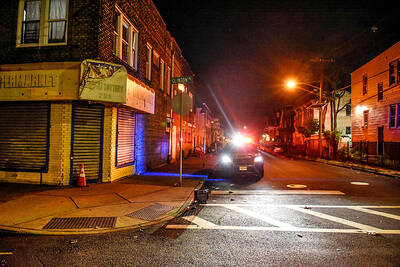One minute, you are being whisked through the busy Belfast shipyard where the Titanic is being built. The next, you are contemplating, amid a chilly piped-in breeze and lights mimicking darkened waters, the horror of freezing to death in the North Atlantic.
In between, Belfast’s impressive new tourist attraction — the £100 million (US$160 million) Titanic Belfast visitor center — offers a loving portrait of the excitement, ambition and opulence surrounding the doomed transatlantic liner.
With 100,000 tickets already sold, Belfast is betting it will deliver a lasting tonic of tourism to the conflict-scarred city. A three-week festival featuring talks, walks and seven Titanic-themed stage shows — including Titanic The Musical — began yesterday to mark the 100th anniversary of the ship’s launching.
A visitor’s first impression will be of the center’s exterior: four jutting prows of the ship, lined in silver steel paneling, six stories high.
Belfast Titanic marketing director Claire Bradshaw said the aim was to create an icon that people would come to associate with Belfast — like the Eiffel Tower for Paris or the Statue of Liberty for New York.
The center sits beside the Belfast Lough dockside where the vessel was built from 1909 to 1911 and set sail for its sea trials on April 2, 1912. The Titanic began its fateful maiden voyage from the English port of Southampton eight days later, striking an iceberg just before midnight on April 14 and sinking within hours with the loss of 1,514 lives.
A roller coaster-like ride takes visitors, up to six per carriage, up and down three floors of a re-creation of the Harland and Wolff shipyards that made the ship for Liverpool’s White Star Line. No, there are no thrills or spills, just a panoramic tour suggesting the scale of the hull and the energy of the dockworkers, all of them video projections of actors in period costumes.
Visitors can hear the commentary in English, Spanish, French, German, Italian or Chinese.
Next, visitors see a four-minute CGI tour of the finished Titanic, rising deck by deck, from engine room to the famed first-class cabin staircase. In the same room are recreations of first, second and third-class cabins, again with video projections of fictional passengers going into their bunks or getting ready for dinner.
Every available wall is plastered, in logical chronology, with details about every phase of construction, every firm and engineering specialty involved and every part described from the ship’s four 7.3m wide funnels to its six onboard pianos.
The ship’s voyage to Southampton, then to its other European ports of call in Cherbourg, France, and Queenstown, Ireland, are detailed in turn: The numbers and notables who boarded, their stories and tales of excitement about the voyage to New York ahead.
An entire wall is given over to a reprint of the final surviving photograph taken of the Titanic on April 11, 1912, as it sailed away from Queenstown, the County Cork port today renamed Cobh.
Around the next corner, Titanic Belfast plunges into the disaster. A series of panels reprints the confused wireless messages among ships as the Titanic appeals, minute by minute, for help from other vessels. The room is deliberately chilly as light projections create an image of dark lapping waters underfoot.
In the next section, visitors are invited to explore the stories of survivors and the final words of those who perished, most impressively by using interactive touch screens that link to family photos, diaries and related newspaper articles. The role of Halifax, Nova Scotia, in receiving 209 bodies buried in the city’s cemeteries is detailed.
Down a stairwell with a wall filled with ghost-white life preservers, visitors can hear and read testimony from the British and US inquests into how the disaster happened. Or they can explore one of several slick touch-screen databases of every passenger and crewmember indexed by name, age, sex, nationality, job, cabin class, port of embarkation — and whether they perished or survived.

DOUBLE-MURDER CASE: The officer told the dispatcher he would check the locations of the callers, but instead headed to a pizzeria, remaining there for about an hour A New Jersey officer has been charged with misconduct after prosecutors said he did not quickly respond to and properly investigate reports of a shooting that turned out to be a double murder, instead allegedly stopping at an ATM and pizzeria. Franklin Township Police Sergeant Kevin Bollaro was the on-duty officer on the evening of Aug. 1, when police received 911 calls reporting gunshots and screaming in Pittstown, about 96km from Manhattan in central New Jersey, Hunterdon County Prosecutor Renee Robeson’s office said. However, rather than responding immediately, prosecutors said GPS data and surveillance video showed Bollaro drove about 3km

Tens of thousands of people on Saturday took to the streets of Spain’s eastern city of Valencia to mark the first anniversary of floods that killed 229 people and to denounce the handling of the disaster. Demonstrators, many carrying photos of the victims, called on regional government head Carlos Mazon to resign over what they said was the slow response to one of Europe’s deadliest natural disasters in decades. “People are still really angry,” said Rosa Cerros, a 42-year-old government worker who took part with her husband and two young daughters. “Why weren’t people evacuated? Its incomprehensible,” she said. Mazon’s

‘MOTHER’ OF THAILAND: In her glamorous heyday in the 1960s, former Thai queen Sirikit mingled with US presidents and superstars such as Elvis Presley The year-long funeral ceremony of former Thai queen Sirikit started yesterday, with grieving royalists set to salute the procession bringing her body to lie in state at Bangkok’s Grand Palace. Members of the royal family are venerated in Thailand, treated by many as semi-divine figures, and lavished with glowing media coverage and gold-adorned portraits hanging in public spaces and private homes nationwide. Sirikit, the mother of Thai King Vajiralongkorn and widow of the nation’s longest-reigning monarch, died late on Friday at the age of 93. Black-and-white tributes to the royal matriarch are being beamed onto towering digital advertizing billboards, on

SECRETIVE SECT: Tetsuya Yamagami was said to have held a grudge against the Unification Church for bankrupting his family after his mother donated about ¥100m The gunman accused of killing former Japanese prime minister Shinzo Abe yesterday pleaded guilty, three years after the assassination in broad daylight shocked the world. The slaying forced a reckoning in a nation with little experience of gun violence, and ignited scrutiny of alleged ties between prominent conservative lawmakers and a secretive sect, the Unification Church. “Everything is true,” Tetsuya Yamagami said at a court in the western city of Nara, admitting to murdering the nation’s longest-serving leader in July 2022. The 45-year-old was led into the room by four security officials. When the judge asked him to state his name, Yamagami, who